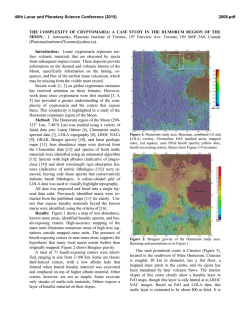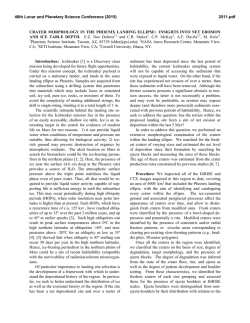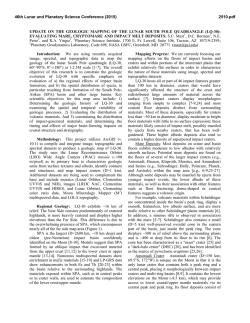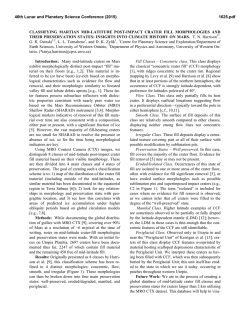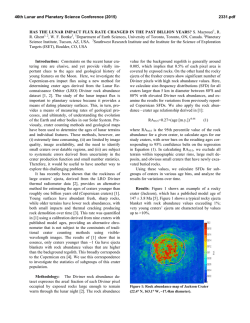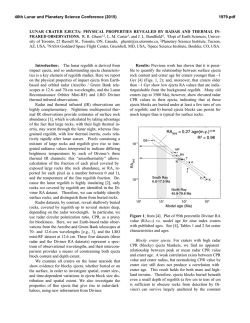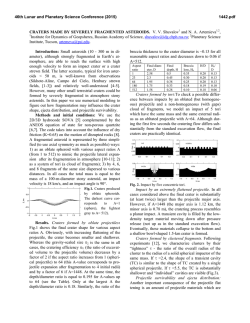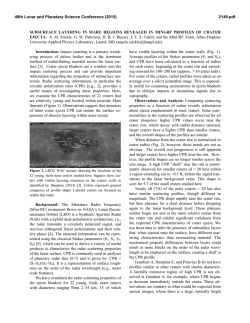
INFERRING THE SUBSURFACE STRUCTURE OF DOUBLE
46th Lunar and Planetary Science Conference (2015) 2096.pdf INFERRING THE SUBSURFACE STRUCTURE OF DOUBLE LAYER EJECTA CRATERS FROM OVERLYING SECONDARY CRATERS. D. Viola1, A. S. McEwen1, C. M. Dundas2, and S. Byrne1. 1University of Arizona, Department of Planetary Sciences, 2USGS Astrogeology Science Center. Introduction: Fluidized ejecta craters, in comparison to the ballistic crater types that are commonly found on the Moon and Mercury, have only been observed on Mars and some icy satellites in the outer solar system [1, 2]. This class of craters includes double layer ejecta (DLE) craters, which are surrounded by two fluidized ejecta layers and are typically observed in the mid-latitudes on Mars [e.g. 1, 3]. This distribution suggests the influence of subsurface volatiles, particularly water ice, in the formation of this type of crater. Several hypotheses for the formation of DLE craters have been proposed, including a base surge [4], atmospheric effects [5, 6], and an impact directly into an icy substrate [7]. Craters can be useful probes for the determination of subsurface properties, including the presence and abundance of volatiles. In particular, secondary craters with “expanded” morphologies, where the central crater bowl is surrounded by a shallow extension (Figure 1), have been observed throughout Arcadia Planitia and nearby areas, in the northern plains of Mars [8]. Expansion is thought to occur after the formation of secondary craters that expose a shallow subsurface layer of “excess” water ice (which exceeds the available soil pore space). This subsurface ice sublimates when exposed to the atmosphere, and the overlying dry material collapses into the crater, gradually building up an insulating layer that prevents further expansion [8, 9]. Preferential expansion related to different terrain types has been observed, including overlying DLE craters, where the degree of expansion appears to vary between the ejecta layers and the surrounding terrain. Figure 1. An example of expanded secondary craters located near 50.17°N, 219.18°E, found in HiRISE image ESP_017875_2305. We therefore propose that these expanded craters can be used to determine variations in the abundance of water ice within the shallow subsurface of each layer of ejecta in DLE craters. Study Area: The focus area of this study is a double layer ejecta crater with a diameter of ~15 km located at 50.35°N, 219.7°E (Figure 2). Overlying secondary craters from an unrelated later impact, many of which show evidence for the expansion described previously, are observed on each ejecta layer. The degree of expansion appears to vary among both ejecta layers and the surrounding terrain. A preliminary analysis of a sampling of expanded secondary craters found in a digital terrain model (DTM) created using stereo images from the High Resolution Imaging Science Experi- Figure 2. Context map. The two ejecta layer boundaries are labeled with dashed lines, and the three study DTMs are numbered. (1) HiRISE stereo pair ESP_027158_2305 and ESP_026446_2305, previously analyzed in [8]. (2) HiRISE stereo pair ESP_ 017875_2305 and ESP_018007_2305. (3) HiRISE stereo pair ESP_034384_2300 and ESP_033738_2300. 46th Lunar and Planetary Science Conference (2015) ment (HiRISE) has been described in [8], and showed quantitative evidence for greater ice content within the innermost ejecta layer. We are conducting a more detailed analysis of this stereo pair and two additional HiRISE DTMs that sample both ejecta layers and the surrounding terrain, the locations of which are shown in Figure 2. Methods: In order to quantify the differences in crater expansion on each ejecta layer, we map the expanded secondary craters that are found in the three DTMs in detail using ESRI’s ArcMap and the CraterHelperTools add-in [10]. Each expanded crater is approximated as an ellipse, and parameters such as diameters (major and minor axes) are measured. Crater volumes, depths, and depth-to-diameter ratios will also be measured using ArcGIS’s 3D Analyst tools to interpolate a pre-impact surface from the topography immediately surrounding the (rimless) expanded craters. This method is described in more detail in [8]. Expanded craters that overlap each other are excluded from volume measurements since it becomes challenging to interpolate their pre-impact surface. Crater volumes can be used as a rough proxy for the volume of ice lost to sublimation during the expansion process due to the fact that any rim and ejecta that was once present around these secondary craters has collapsed into the crater during expansion [8]. Discussion: By comparing the volumes and sizefrequency distributions of the expanded secondary craters overlying each layer of the DLE crater, we will approximately quantify the differences in ice content within the inner and outer ejecta layers (assuming the initial secondary cratering was comparable on each layer). This has implications for the formation mechanism of DLE craters and the material properties of the ejecta layers. It is interesting to note that there are several small hills in the southern section of DTM 3 in Figure 2 which have a texture similar to the ejecta and preserve overlying expanded secondary craters, but appear unrelated to the DLE crater. Like the DLE crater ejecta, these features preserve subsurface excess ice and may have a composition similar to the ejecta. The formation of excess ice has been linked to regolith that contains clay-sized particles or perchlorate salts [11], so it is conceivable that excess ice developed after the DLE crater-forming impact, and was related to the type of material comprising the ejecta layers. Another possibility is that some excess ice is snow preferentially trapped in certain topographic settings. In this case, understanding crater expansion would inform us about differences in the materials or geomorphic properties of the two ejecta layers, rather than explicitly deriving from the original ice content. 2096.pdf Each hypothesis for DLE crater formation implicates different compositions for the ejecta layers. The base surge hypothesis suggests that the inner layer was deposited by ballistic and flow processes, whereas the outer ejecta layer, emplaced by a base surge, is comprised of fine-grained materials that were lofted and deposited around the crater [4]. Atmospheric effects have also been implicated as a factor in the production of ejecta blankets on Mars, including in fluidized ejecta, where aerodynamic drag can lead to particle size sorting of ejected material [5]. The glacial substrate model proposed that DLE craters result from an impact into an icy surface, preserving a layer of ice and snow beneath the ejecta and leading to a landslide of material close to the rim in order to produce the inner ejecta layer [7]. Quantification of the volume of ice preserved beneath our study crater will provide some constraints on the subsurface material properties within each ejecta layer and help to clarify the formation of double layer ejecta craters on Mars. References: [1] Mouginis-Mark P. (1981) Icarus, 45, 60-76. [2] Boyce J. et al. (2010) Meteoritics & Planet. Sci., 45, 638-661. [3] Barlow N. G. and Bradley T. L. (1990) Icarus, 87, 156-179. [4] Boyce J. M. and Mouginis-Mark P. J. (2006) JGR, 111, E10005. [5] Schultz P. H. and Gault D. E. (1979) JGR, 84, 7669-7687. [6] Schultz P. H. (1992) JGR, 97, 1162311662. [7] Weiss D. K. and Head J. W. (2013) GRL, 40, 3819-3824. [8] Viola D. et al. (2015) Icarus, 248, 190-204. [9] Dundas C. M. et al. (2014) 8th Intl. Conf. Mars, Abstract #1375. [10] Nava R. A. (2011) USGS, Crater Helper Tools for ArcGIS 10.0. [11] Sizemore H. G. et al. (2014). Icarus, accepted manuscript, http://dx.doi.org/10.1016/j.icarus.2014.04.013.
© Copyright 2026
